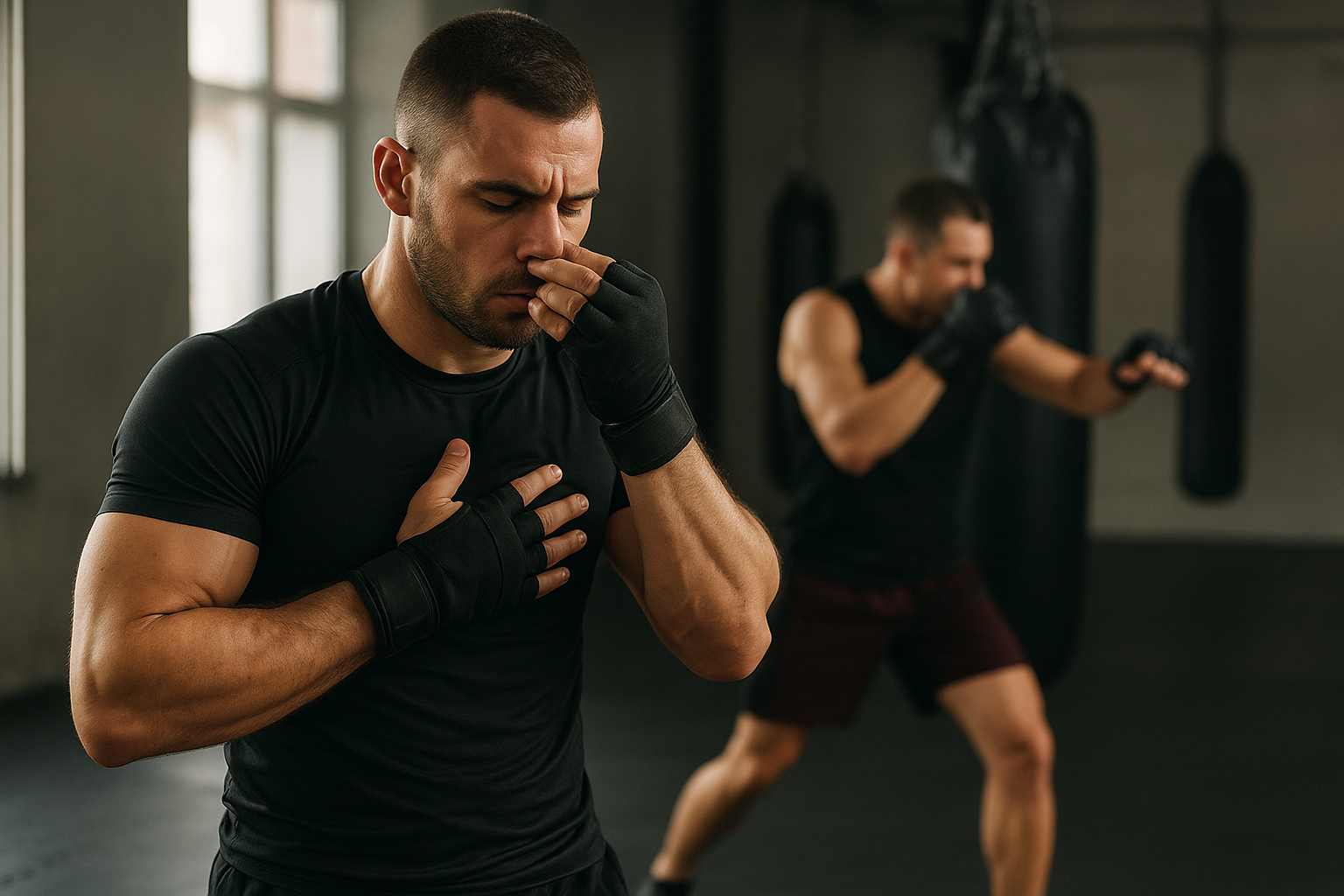Introduction: Why Breathing Matters in Combat Sports
Power, endurance, and concentration are generally the deciding factors when you enter the ring, cage, or mat. Breathing is perhaps one of the most neglected training components in combat sports. Athletes spend endless hours sharpening their strikes, grappling techniques, and conditioning, but without mastering the science of breathing, much of that hard work is left untapped.
Breathing is more than just inhaling and exhaling—it’s the gateway to maximizing oxygen intake, controlling energy expenditure, and sharpening mental clarity. Fighters who breathe correctly can hit harder, last longer, and think clearer under pressure. This article explores the science of breathing in combat sports and provides actionable strategies to improve stamina, power, and performance.
The Physiology of Breathing
How Oxygen Fuels Muscles
Adenosine triphosphate (ATP), which powers your muscles, is highly dependent on oxygen. During combat sports, every punch, kick, or takedown requires explosive energy. Efficient breathing ensures oxygen delivery to working muscles, preventing premature fatigue.
The Role of Carbon Dioxide in Endurance
The majority of athletes believe that oxygen is the issue that limits their endurance. In actuality, tolerance to carbon dioxide is more important. Rising CO₂ levels, not oxygen deficiency, are frequently the cause of the desire to breathe.
Diaphragmatic vs. Chest Breathing
The capacity of the lungs and the absorption of oxygen are restricted by shallow chest breathing. By pulling air deep into the abdomen, diaphragmatic breathing improves oxygen exchange, stabilises the core, and aids in rhythm maintenance during intense exchanges.
Common Breathing Mistakes Athletes Make
Holding Breath During Strikes
A common error in boxing and MMA is holding the breath while throwing punches or executing grappling moves. This reduces power output and increases fatigue.
Shallow Breathing Under Pressure
When adrenaline spikes, fighters often unconsciously shift to shallow, rapid breaths. This reduces oxygen intake, spikes heart rate, and accelerates exhaustion.
The Link Between Breathing and Stamina
VO₂ Max and Athletic Performance
VO₂ max measures how efficiently your body uses oxygen during exercise. Improving breathing technique directly enhances VO₂ max, allowing fighters to push harder without burning out.
How Controlled Breathing Delays Fatigue
Proper breath control helps regulate heart rate and prevents early lactic acid buildup. Fighters who master breathing can maintain pace in later rounds while opponents struggle.
Breathing for Power in Combat Sports
Exhaling During Strikes and Explosions
Explosive movements like punches, kicks, and takedowns should always be paired with sharp exhales. This engages core muscles, increases speed, and protects the body from injury.
Synchronizing Breath with Movement
The best fighters breathe rhythmically, syncing inhales with defense and exhales with offense. This coordination saves energy and keeps movements fluid.
Techniques to Improve Breathing Efficiency
Box Breathing for Calm and Focus
Navy SEALs and professional sportsmen frequently employ box breathing, commonly referred to as four-square breathing. Four seconds are spent inhaling, four seconds are spent holding, four seconds are spent exhaling, and four seconds are spent holding. This practice helps fighters control nerves before stepping into the ring, while also building endurance under stress.
The Buteyko Method for Endurance
The Buteyko method focuses on reducing over-breathing and improving CO₂ tolerance. Fighters train by breathing slowly through the nose and limiting exhalation. This conditions the body to operate efficiently with higher CO₂ levels, boosting stamina during long bouts.
Breath-Hold Training for Anaerobic Capacity
Breath-hold exercises simulate oxygen debt, much like the intense scrambles in MMA or grappling. Training the body to work without oxygen for short bursts improves anaerobic capacity, ensuring you can power through explosive movements without gassing out.
Breathing in Different Combat Sports
Boxing
In boxing, rhythmic breathing is crucial for maintaining pace over multiple rounds. Every punch should be delivered with a sharp exhale to boost striking force and prevent winding.
MMA
The combination of punching, wrestling, and submissions in mixed martial arts necessitates flexible breathing. Fighters must switch between explosive striking and controlled breath management during grappling exchanges.
Muay Thai
Muay Thai fighters are known for their distinct sharp exhales with every strike. This not only increases power but also creates a psychological edge by intimidating opponents with audible rhythm.
Brazilian Jiu-Jitsu
In BJJ, breath control can mean the difference between survival and submission. Fighters who panic and hyperventilate when caught in a choke lose faster. Calm diaphragmatic breathing maintains mental clarity and conserves energy.
Mind-Body Connection: Breathing and Mental Toughness
How Breath Control Reduces Stress and Anxiety
Combat sports are as much mental as they are physical. Breath control activates the parasympathetic nervous system, lowering cortisol levels and reducing fight-night anxiety.
The Role of Breathing in Focus and Reaction Time
A consistent breathing pattern improves mental clarity, enabling fighters to perceive opponents more accurately and respond more quickly. During stressful situations, controlled exhalation maintains decision-making sharp and avoids tunnel vision.
Practical Breathing Drills for Fighters
Shadowboxing with Breathing Patterns
Incorporate breathing into shadowboxing by exhaling sharply with each punch and inhaling between combos. This develops rhythm and improves conditioning.
Resistance Breathing with Training Masks
Training masks simulate high-altitude conditions by restricting airflow. While controversial, they can help strengthen respiratory muscles and increase lung efficiency when used properly.
Partner Drills to Maintain Rhythm Under Pressure
Sparring drills that emphasize breathing—such as counting exhales during exchanges—help fighters maintain composure when fatigue and adrenaline peak.
Nutrition, Recovery, and Breathing Synergy
How Hydration Affects Lung Capacity
Dehydration thickens mucus in the airways, reducing airflow efficiency. Proper hydration keeps the respiratory system clear and improves oxygen delivery during fights.
Breathing and Sleep Recovery
Breathing quality at night influences recovery. Mouth breathing during sleep can reduce oxygen intake and impair rest. Nasal breathing and even mouth tape (for some athletes) are used to improve sleep quality and recovery.
Advanced Breathing Hacks from Elite Fighters
Insights from Olympic Boxers
Olympic boxing coaches emphasize breath drills just as much as footwork. Fighters who control their exhale during combinations stay light and quick after several rounds.
Lessons from Navy SEAL Breath Training
Elite military units train breath control to stay calm under life-threatening conditions. Fighters can borrow these methods to maintain composure in high-stakes matches.
FAQs on The Science of Breathing in Combat Sports
Q1: Why is breathing important in combat sports?
Breathing affects stamina, power, and mental clarity. Fighters who breathe efficiently last longer and recover faster.
Q2: Should I breathe through my nose or mouth during fights?
Nasal breathing is ideal for training and recovery, while exhaling through the mouth during strikes is best for maximizing power.
Q3: Can breathing exercises really improve stamina?
Yes. Techniques like box breathing, the Buteyko method, and breath-hold training directly improve lung efficiency and CO₂ tolerance.
Q4: How do I stop gasping for air in fights?
Train diaphragmatic breathing, condition your CO₂ tolerance, and practice syncing breath with movement.
Q5: Do elite fighters focus on breathing?
Absolutely. From Muay Thai to MMA, top athletes integrate breath control drills into daily training.
Q6: Does inadequate breathing impact one’s ability to concentrate during combat?
Yes. Shallow or erratic breathing increases stress hormones and clouds judgment, while controlled breathing sharpens focus and reaction speed.
Conclusion: Breathing as the Ultimate Weapon in Combat
The science of breathing is often underestimated in combat sports, yet it’s one of the most powerful tools a fighter can master. Proper breath control enhances stamina, sharpens focus, delays fatigue, and maximizes striking power. Whether you’re a boxer, MMA fighter, or BJJ practitioner, learning how to breathe correctly could be the missing link that elevates your performance from good to unstoppable.
Mastering breathing doesn’t just keep you alive in the fight—it helps you dominate it.

